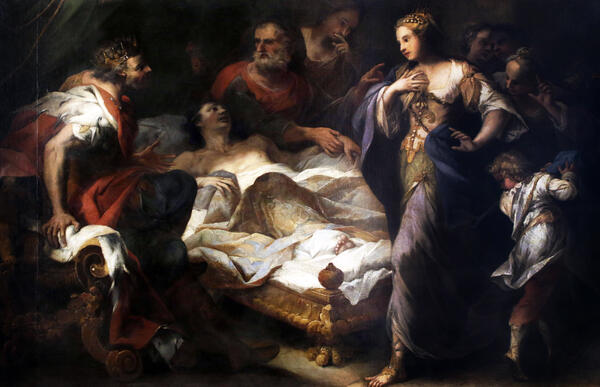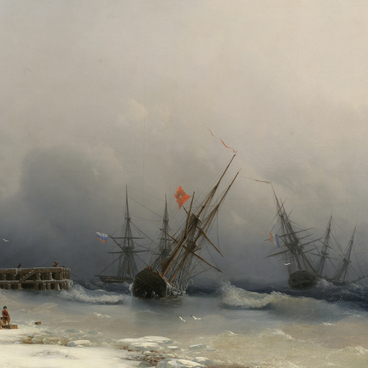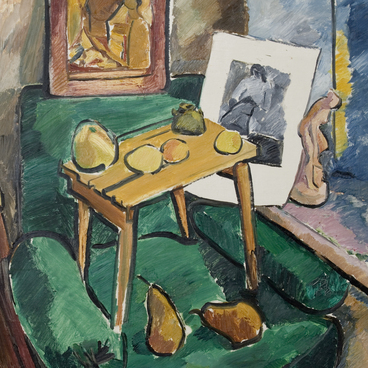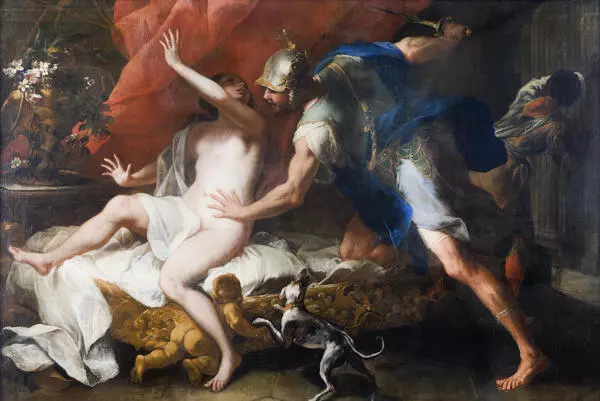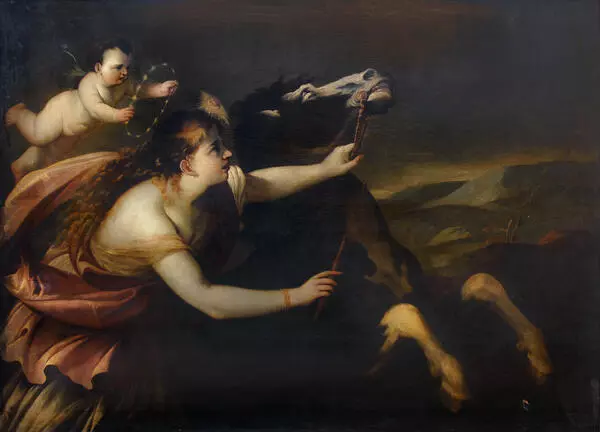A bright representative of the Neapolitan school acknowledging the Baroque style’s virtuoso, Luca Giordano enjoyed fame as a master of frescoes, religious and historical compositions. The artist did works for churches, noble grandees in Italy, and Spain, at the European courts, performing many frescoes and canvases throughout his life.
“Antiochus and Stratonice” is painted based on a plot from Greek history. Seleucus I Nicator’s son, Antiochus, fell seriously ill. The court doctor Erasistratus took the young lad’s pulse and defined his ailment’s cause — love for his stepmother Stratonice. The king had to concede his young wife to his son. They had a wedding party, and Antiochus received the king’s title and went to rule “Upper Asia” by the will of his father.
The large-format canvas presents a brightly costumed scene with many characters enclosed in a dynamic oval-shaped composition. There is a compositional gap in the foreground, a certain vacuum, so that the audience can instinctively feel part of the cycle of court events. All the characters depicted a certain emotional state. Stratonice has a “talking” gesture pressing her hand to her bosom in amazement, and the little boy, Page, is painted in a twisted perspective — turning back abruptly having heard about Antiochus’s love for his stepmother.
This work fully illustrates Baroque’s definition as “the art of a frozen moment” characterized by global perception and immensity of visualization, luxury, dynamics, rapid movement, exciting angles, and intricate posing.
Luca Giordano had a developed sense of beauty and surprising resourcefulness of imagination. His works characterize liveliness, harmonious color, a solid professional basis of drawing and painting, the perfection of technique, spectacular effects of light and shade, a “delirious” outrageous manner of artwork, and at the same time, the grace of academic art and freedom of decorative style. For energy, speed, and outstanding efficiency, his contemporaries nicknamed him “Luca Fa-Presto” from his youth, meaning “makes it fast, rapidly”.
“Antiochus and Stratonice” is painted based on a plot from Greek history. Seleucus I Nicator’s son, Antiochus, fell seriously ill. The court doctor Erasistratus took the young lad’s pulse and defined his ailment’s cause — love for his stepmother Stratonice. The king had to concede his young wife to his son. They had a wedding party, and Antiochus received the king’s title and went to rule “Upper Asia” by the will of his father.
The large-format canvas presents a brightly costumed scene with many characters enclosed in a dynamic oval-shaped composition. There is a compositional gap in the foreground, a certain vacuum, so that the audience can instinctively feel part of the cycle of court events. All the characters depicted a certain emotional state. Stratonice has a “talking” gesture pressing her hand to her bosom in amazement, and the little boy, Page, is painted in a twisted perspective — turning back abruptly having heard about Antiochus’s love for his stepmother.
This work fully illustrates Baroque’s definition as “the art of a frozen moment” characterized by global perception and immensity of visualization, luxury, dynamics, rapid movement, exciting angles, and intricate posing.
Luca Giordano had a developed sense of beauty and surprising resourcefulness of imagination. His works characterize liveliness, harmonious color, a solid professional basis of drawing and painting, the perfection of technique, spectacular effects of light and shade, a “delirious” outrageous manner of artwork, and at the same time, the grace of academic art and freedom of decorative style. For energy, speed, and outstanding efficiency, his contemporaries nicknamed him “Luca Fa-Presto” from his youth, meaning “makes it fast, rapidly”.

